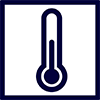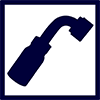Hydraulic Hose SelectionS.T.A.M.P.E.DProper Hydraulic Hose SelectionIn order to maintain a safe hydraulic hose system, proper hydraulic hose and fittings selection is essential. A simple way to determine the correct system for your hydraulic hoses is to remember STAMPED: Size, Temperature, Application, Material, Pressure, Ends, and Delivery (Volume).
 Size - The hydraulic hoses you select need to be the correct size for your application in order to maintain a safe hydraulic system. An incorrectly sized hose will lead to pressure loss and heat damage of the hose as a result of excessive movement.
Size - The hydraulic hoses you select need to be the correct size for your application in order to maintain a safe hydraulic system. An incorrectly sized hose will lead to pressure loss and heat damage of the hose as a result of excessive movement.
 Temperature - The hose you choose must be able to handle the minimum and maximum temperatures of your hydraulic system. You also need to consider both the temperature of the fluid that will be running through the hose and the ambient temperature that the hose will be exposed to before purchasing the hydraulic hose.
Temperature - The hose you choose must be able to handle the minimum and maximum temperatures of your hydraulic system. You also need to consider both the temperature of the fluid that will be running through the hose and the ambient temperature that the hose will be exposed to before purchasing the hydraulic hose.
 Application - Consider where and how the hydraulic hose swill be used. Think about how long you need the hose to last, the hydraulic fittings thread connection type, the environment the hose will be used in, if there are any government or industry standards that need to be met, and bend radius, among others. Choose the type of hose most suited to the environment and applications of your hydraulic systems.
Application - Consider where and how the hydraulic hose swill be used. Think about how long you need the hose to last, the hydraulic fittings thread connection type, the environment the hose will be used in, if there are any government or industry standards that need to be met, and bend radius, among others. Choose the type of hose most suited to the environment and applications of your hydraulic systems.
 Material - Hydraulic hoses can be used to carry a multitude of liquids and gasses. Before installing your hydraulic hose and fittings, check to see if the material of the hose and the contents that will be traveling through the hose are compatible. When selecting a hose to be used in gaseous applications, take extra care to select the correct type of hose so that no permeation can occur.
Material - Hydraulic hoses can be used to carry a multitude of liquids and gasses. Before installing your hydraulic hose and fittings, check to see if the material of the hose and the contents that will be traveling through the hose are compatible. When selecting a hose to be used in gaseous applications, take extra care to select the correct type of hose so that no permeation can occur.
 Pressure - It is crucial that the published working pressure of your hydraulic hose is equal to or greater than the pressure of the hydraulic system. If the pressure of the hydraulic system exceeds the pressure limit of the hydraulic hoses, a leak or a burst hose could develop.
Pressure - It is crucial that the published working pressure of your hydraulic hose is equal to or greater than the pressure of the hydraulic system. If the pressure of the hydraulic system exceeds the pressure limit of the hydraulic hoses, a leak or a burst hose could develop.
 Ends - Hydraulic Hose end connectors, or couplings, are hydraulic hose fittings that are crimped on to the ends of hydraulic hoses. To establish what type of fitting you need, find the pressure rating and verify the application of the hose. Once you have determined the appropriate end connector, Select Your Hydraulic Hose Fittings.
Ends - Hydraulic Hose end connectors, or couplings, are hydraulic hose fittings that are crimped on to the ends of hydraulic hoses. To establish what type of fitting you need, find the pressure rating and verify the application of the hose. Once you have determined the appropriate end connector, Select Your Hydraulic Hose Fittings.
.png) Delivery (Volume) - Determine how much fluid will be going through the hose. This will establish what size of hose to be used. An oversized hose will add unneeded bulk, weight, and cost. An undersized hose will lead to elevated pressure loss, reduced flow, and total system underperformance.
Delivery (Volume) - Determine how much fluid will be going through the hose. This will establish what size of hose to be used. An oversized hose will add unneeded bulk, weight, and cost. An undersized hose will lead to elevated pressure loss, reduced flow, and total system underperformance.
|
